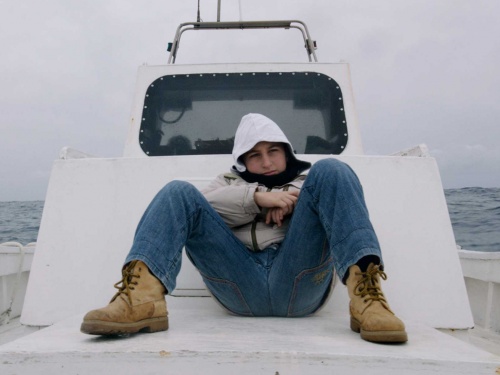Emergence
Curatorial discourse and the contested trope of emergence
Dave Hickey, in a recently printed roundtable transcript, declares that his position on curating is that the meaning of the show emerges from the show itself. The curator is a more or less inspired art herder.
1 He goes on to assert that this is what curators are doing: they are flying around to national capitals, taking government-paid tours to look at government-approved artists that are biennial-friendly. Curating is a very corrupt discourse.
There are two issues of interest in Hickey's provocations. Firstly, there is the posited antagonism between art criticism and curatorial discourse as rival modalities in the discursive recuperation of art practice: curatorial discourse, as presented by Hickey, is in the ascendant position and therefore in need of debunking. Secondly, curatorial discourse is presented as aligned with the dynamics of a globalised art world, within which various national interests compete with each other for the attentions of highly mobile trans-national bearers of symbolic capital – this scenario is signalled through the figure of the travelling curator and the ubiquitous biennial.
However, there is a further point of interest in Hickey's remarks, and that is the way in which the rhetorical topos of emergence operates as an anchor for authenticity. While curatorial discourse is declared corrupt, the self-actualising process of meaning-formation that emerges "from the show itself" is construed as uncontaminated: what is self-generated or emergent is the counter-point to the inauthentic machinations of the 'art herding' curator.
Ironically, contra Hickey, this figuring of authentic culture as emergent and self-organised – rather than commissioned, prescribed or authored from elsewhere – is precisely one of the most important themes within the curatorial discourse of the last two decades, particularly in a European context. While it would be a gross distortion to present curatorial discourse as univocal and monolithic, it is still appropriate to note the recurrence of certain themes across the divergent debates and practices of curators in recent decades. One such theme is precisely the trope of emergence and the dialogical negotiation of artworks into public existence through the organic, open-ended co-production and conversation of artists, curators, artist-curators and other players. However, privileging the emergent as the locus of the authentic pre-dates the appearance of curatorial discourse itself.
In Marxism and Literature Raymond Williams constructs a triumvirate of dominant, residual, and emergent
cultural moments.2 While the dominant may be taken as read, residual cultural elements are those that operate at some distance from effective dominant culture but are still part of it. The residual comprises those cultural elements that derive from a grand tradition and are employed in legitimating contemporary social relations, while operating in a largely marginal space. Williams argues that this incorporation of the residual through reinterpretation, dilution, projection, discriminating inclusion and exclusion
is the work of selective tradition. On the other hand, emergent cultural innovation comprises new practices that produce new meanings, values and kinds of relationships. Emergence is thus not the mere appearance of novelty: it is the site of dialectical opposition to the dominant – the promise of overcoming, transgressing, evading, renegotiating or bypassing the dominant – and not simply delivering more of the same under the blandishments of the new.
Truly emergent practices, Williams argues, are difficult to distinguish from those that are simply new phases in the dominant culture and thus merely novel. Practices that are emergent in the strict sense provide real alternatives to sanctioned cultural experiences, behaviours and values. What matters for Williams in emergent culture, as distinct from residual or dominant culture, is that – while it will always depend on finding new forms or adaptations of form – it contains an element of implicit or explicit critical dissent. There is of course a longstanding co-option of the rhetoric of emergence by the art market, as evidenced in the cliché of emergent artists. This co-option makes the discernment of the truly emergent all the more complex, engaging the uncertain dynamics of authenticity as both a point of resistance and a point of sale.
Arguably, curatorial discourse – or rather a specific sub-formation within curatorial discourse – has functioned as an important cultural matrix in recent decades. Curatorial discourse has enabled a range of critical innovations which contest the dominant culture across a number of institutional sites and practices – art education, art museums and galleries, biennials, public art programmes, urbanism, and art publishing to name only some of the most prominent. In order to understand how curatorial discourse operates as an engine of emergence, it will help to consider the growth of curatorial discourse in its own right.
The emergence of curatorial discourse
Curating – a cultural practice once associated primarily with the care and selection of works for display, usually in the context of a gallery or museum – emerged in the late 1960s as a creative, semi-autonomous and individually-authored form of mediation (and production). By the time Harald Szeemann curated Documenta 5: Questioning Reality, Pictorial Worlds Today (1972), the position of the individual curator had already opened up to wider international debate. This debate was accompanied by a shift of emphasis in the criticism of art: away from the primary critique of the artwork as an autonomous object of study; towards a mode of curatorial criticism in which the curator becomes a central subject of critique. The critical response to Documenta 5, for example, focused on Szeemann's alleged over-emphasis of his own curatorial concept rather than on consideration of the artworks in the exhibition.
The idea of a curatorial remit operating above and beyond the interests of the artist, or the notion of the discrete art work, opened up a space of critical contestation – one which, ironically, reflected how artists were increasingly concerning themselves with mediation and the language of mediation, as they turned towards conceptual strategies – and began to address the curated exhibition as a cohesive cultural text. In this sense, the analysis of curating that developed in the 1960s, founded on the demystification of the art system – originating in opposition to the dominant order – became a discussion about the work of exhibition construction, and its production of meanings and values. While for some curating, even now, is yet to be fully established as an historical discourse and academic field of enquiry, it is clear that by the late 1990s the institutionalisation of curating was well underway: with the appearance of curatorial study programmes; the rise of nomadic über-curators, linked to the rising international biennial curatorial market; and the creation of a range of formal spaces for the discussion of curating. In the 1990s, in the English-speaking world, one of the main features of this new era was the development of publications specifically examining the histories of curatorial innovations and models, as well as their potential links to an evolving practice.
During this time, individual curators became the subject of discussion and a process of historicisation began to take shape, at the same time as major transformations were realised in contemporary curatorial praxis. As Helmut Draxler argued in 1992, the early 1990s were already being recognised as a period of institutionalisation for the curator, with the flourishing of curatorial training programmes following an initial institutional shift in the course of the sixties, which [came] from a certain uneasiness with respect to the inescapability of museums as well as other exhibition institutions to react to new forms of expression in art.
3 What Draxler could not have foreseen was that the institutionalisation of the curator's function was only the first stage in the development of an expansive curatorial discourse – and an accompanying publishing industry – led by, and for, a new generation of self-conscious and reflexive curators.
In their introduction to Thinking About Exhibitions (1996), Bruce Ferguson, Reesa Greenberg and Sandy Nairne highlighted what they called the emergence and consolidation of a new discourse on art exhibitions
and stated their intention to bring into debate a range of issues at play in their formation and reception.
4 Their eclectic selection of texts focused mainly on twentieth-century exhibition histories – curating, exhibition sites, forms of installation and spectatorship – in an attempt to demonstrate how the discourse around exhibitions had changed dramatically since the 1980s and to show how, in the 1990s, focus on art exhibitions was indicative of the political and cultural agency of so many of the debates centred on and fostered by exhibitions.
5 The impact of key exhibitions on the history of art had already been highlighted by Bruce Altshuler a couple of years earlier, when he claimed that the history of the avant-garde – from the early twentieth-century avant-garde through the vanguard of the 1960s – was characterised by a dialogue between a community of artists and the public, one based on acceptance and rejection, with all participants enmeshed in systems of personal and economic relations.
6
For Michael Brenson, the curator's moment had truly arrived by the mid-1990s, with the emergence of biennials, organised international meetings and curatorial summits:
After listening to heads of international biennials and triennials speak to one another for three days about their hopes and concerns, it was clear to me that the era of the curator has begun. The organisers of these exhibitions, as well as other curators around the world who work across cultures and are able to think imaginatively about the points of compatibility and conflict among them, must be at once aestheticians, diplomats, economists, critics, historians, politicians, audience developers, and promoters. They must be able to communicate not only with artists but also with community leaders, business executives, and heads of state... The texture and tone of the curator's voice, the voices it welcomes or excludes, and the shape of the conversation it sets in motion are essential to the texture and perception of contemporary art.Michael Brenson7
The expansion of curatorial discourse was accelerated by the advent of curatorial training programmes in the early 1990s. Students and programme leaders began to look at existing exhibition models and a relatively small number of established curatorial precedents, focusing on exhibition history and scrutinising the curatorial component instead of the artwork(s). Thirdly, since the 1990s, the discourse around the figure of the biennial curator has created a market for a nomadic type of global curator, during a time when new associations were being attached to curating, as a potentially creative form of cultural practice and as a possible career choice for artists, art historians, critics and art administrators.
The 1990s saw an attempt to formulate a new lexicon and rhetorical armature for curating as a diverse, internationalised practice. Through these articulations the individualised curatorial act became a central concept, but did so in a manner that also troubled the authorial function of the curator. Curating by the late 1990s and through the early 2000s had come to be represented as an adaptive discipline, using inherited codes and rules of behavior. There is now a long list of metaphors that attempt to reconcile diverse modes of practice, with the curator envisaged as editor, DJ, technician, agent, manager, platform-provider, promoter and scout, or – more absurdly – as diviner, fairy godmother and, even, god.
Since the late 1990s, the discussion around curating has acknowledged the subjective and authorial nature of exhibition-making, and the importance of a growing awareness of the curator's part in shaping exhibitions.8 It is indicative of this that art magazines, over the past five years, have begun to focus on curatorial practice as one of their major subjects for discussion: discussions which have, in turn, largely been led by invited curators. One explanation for this focus may simply be that many critics and professional art writers are now primarily curators, but there are also other factors in play.
A parallel publishing industry has developed around the curator's enhanced visibility. The ubiquity of the curator, the relative absence of published material on the subject of curating and, most signifi cantly, the growth of a new audience has meant that an ever-increasing number of curators, curatorial students and graduates are now in search of relevant material – thus generating a significant readership. The period of professionalisation experienced in the 1990s by curators and artists alike generated a new market and a new-found field of study, one centred upon the medium of the exhibition and those involved in its mediation. However, curatorial discourse remains diverse, so that the mainstreaming of this discourse does not exhaustively dictate its possibilities.
Curatorial discourse as an engine of emergence
One might be tempted to assume that this narrative of the appearance of curatorial discourse, and its new-found accommodation within the art journals, should now culminate in a moment of cultural dominance – however, this would be to make a premature. Indeed, this is where Dave Hickey's declarations against curating are at their weakest: they are lazy and largely inattentive to the diversity of strategy and engagement manifest in the range of actual curatorial practice (it is notable again and again that in art criticism the curatorial function is crudely reduced to exhibition making). For, if one looks, however summarily, at the diverse strategies that curatorial discourse has opened up, it is apparent that the discourse has operated as a rhetorical matrix providing for the appearance of a range of new and critical practices. And here we return again to this trope of emergence and the associated values of self-organisation and, indeed, the search for notions of authentic agency that escape the dead-end heroics of avant-gardism.
The argument we propose is that curatorial discourse has acted as an engine of emergence for a set of contemporary practices, ones that do not simply rehearse the marketing of inconsequential novelty. Curatorial discourse has done so by providing a diverse rhetoric of agency, which overcomes the flawed creator-genius machismo and heroic individualism of avant-gardism, while re-instating a sense of individual and collective agency through a range of animating metaphors and theoretical positions: from DIY culture to DJ culture; postproduction to informal networking; dialogical aesthetics to discursive practice. While the extensive and seemingly unending arguments of curatorial discourse have at times seemed tediously self-regarding, it is very important to reassert the potency of this speech in re-establishing, or at least bolstering, a coherent sense of agency in contemporary art practice; and in fostering frameworks for greater interaction with other disciplines and cultural practices.
This is not to say that curatorial discourse has been, or continues to be, a uniformly 'good thing'. Rather this is to assert that within the multiplicity of curatorial discourse many possibilities have opened – however temporarily and with whatever fragility – for cultural practitioners to forge practices of self-organised cultural dissent and creative contestation. In part these possibilities have been created by the emergence of alternative reputational economies that are not circumscribed by the market, and which are not necessarily destined to be 'cashed-in'. Paradoxically, these practices of self-organisation have been enabled in part by their ability to feed precariously from the margins of the market. The precariousness of dissent within a largely market-driven culture and society has required us to generate new rhetorics of impurity and contingency: curatorial discourse has generated – and will continue to generate – these enabling figures, metaphors and tropes.
Dr Paul O'Neill is an artist, curator and writer. He is GWR Research Fellow with Situations at the University of the West of England, where he is leading the international research project Locating the Producers.
Mick Wilson is an artist, educator and writer. He is Dean of the Graduate School of Creative Arts & Media, Dublin, Ireland.
Notes
1The State of Art Criticism, Eds. James Elkins and Michael Newman. London and New York, Routledge, 2008.
2 Raymond Williams, Marxism and Literature, Oxford and New York, Oxford University Press, 1986 [originally 1977], pp. 121–126.
3 Helmut Draxler. 'The Institutional Discourse', Meta 2: A New Spirit in Curating, Stuttgart, Kunstlerhaüs Stuttgart, 1992, p. 18.
4 Reesa Greenberg, Bruce Ferguson and Sandy Nairne's 'Introduction,' in Thinking About Exhibitions, Eds. Bruce Ferguson, Reesa Greenberg and Sandy Nairne, London and New York, Routledge, 1996. p.2.
5 Ibid. pp. 3–4.
6 Bruce Altshuler, The Avant-Garde in Exhibition: New Art in the 20th Century, Berkeley and London, University of California Press, 1994. p. 8.
7 Michael Brenson, 'The Curator's Moment – Trends in the Field of International Contemporary Art Exhibitions', Art Journal, 57: 4, (Winter, 1998), p. 16.
8 Catherine Thomas, 'Introduction', The Edge of Everything: Reflections on Curatorial Practice, Ed. Catherine Thomas, Banff, Canada, Banff Centre Press, 2000. p. ix.
This article is posted in: Articles
Tagged with: Nought to Sixty





